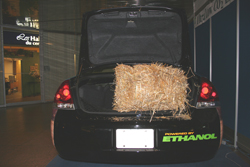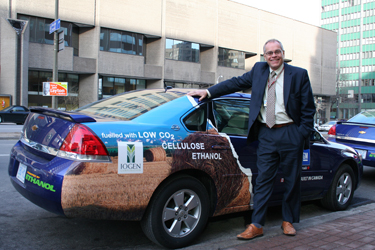Running On Straw
Air Date: Week of December 9, 2005

(Living on Earth/World Media Foundation)
Ethanol is a fuel traditionally made from corn and it’s been getting attention as an alternative to fossil fuels. But the leftovers of corn and other crops may prove an even better fuel resource. At the Montreal Climate Change Conference host Steve Curwood takes a ride in a car fueled by wheat straw and talks with Jeff Passmore, executive vice president of Iogen Corporation of Canada, about the benefits of using cellulose ethanol to power vehicles.
Transcript
CURWOOD: Here at the climate change talks in Montreal there is no shortage of businesses showcasing their latest green innovations in hopes of attracting greenbacks. Their booths line an expo center just across the street from the main conference hall. Big players like GE are here along with entrepreneurs in new technologies…like this man standing alongside a Chevy Impala that looks like it’s just been down on the farm.
PASSMORE: Hi, I’m Jeff Passmore.
CURWOOD: Hi, Jeff. I’m Steve Curwood with Living on Earth.
PASSMORE: Nice to meet you.
CURWOOD: So, I’m looking at this car here with a bale of straw sticking out the back.

(Living on Earth/World Media Foundation)
CURWOOD: Like where the gas tank would be.
PASSMORE: Well, that bale of straw is just to represent what we use to fuel this vehicle. This is a flexible fuel vehicle, and those vehicles can run on anything from 100 percent gasoline, to only 15 percent gasoline, 85 percent ethanol, or any blend in between. The car doesn’t care. It just makes the adjustments automatically.
CURWOOD: But you can run on straw?
PASSMORE: Well, that’s what our ethanol is from, yes. Conventional ethanol comes from grain, and typically, in the U.S., 99 percent of it is coming from corn. But we’ve developed a process at Iogen for making ethanol from agriculture residues. So, in the case of corn, we wouldn’t use the grain, we’d use the cobs and stalks and leaves. Or, in the case of wheat and barley, we would, again, not use the grain, we’d use the straw. So, the ag residues. And in the U.S., there’s, well, I think it’s like 250 – 300 million tons of corn stovers, is what it’s called, the cobs and stalks and leaves. So it could establish a very substantial industry there.
CURWOOD: You have this chart that shows the clean fuels cycle. Now, at one point you have the logo of your company, the Iogen Corporation, and on the other side you have the sun.
PASSMORE: Right.
CURWOOD: Walk me through this. We go from the sun to…
PASSMORE: Growing crops. You go from the sun to growing crops, and we turn those crops into, basically, power and fuel. That’s because we take the cellulose in stuff like this straw and turn that into fermentable sugars to make alcohol, which is what ethanol is, and we take something else called lignin, l-i-g-n-i-n. Lignin is the glue or the tar of Mother Nature that causes trees and crops and grasses to stand up straight and stay together. That has 80 percent of the BTU value of regular thermal coal. So it is separated out, the cellulose goes to make fuel and the lignin is used to make power.
CURWOOD: So let’s check out your fuel over here. We have a straw bale here.
[RUSTLING SOUND]
PASSMORE: We have a straw bale, that’s right, and that’s wheat straw. And, basically, that was just lying in the field, on a farmer’s field. And typically what happens to this straw is either it is plowed under, or farmers just light a match to their fields to burn it to get rid of it, or they sometimes bale it and use it for animal bedding, you know, for cattle and things like that. So what we want to do is turn it into a slightly higher-value product. And for every ton of straw that you bring in you get about 330 liters of ethanol. So two of those big square bales would give you about 330 liters of fuel.

Jeff Passmore of Iogen stands in front of a flexible fuel vehicle powered by cellulosic ethanol. (Living on Earth/World Media Foundation)
CURWOOD: What’s the secret? What do you guys do to turn this into fuel? It doesn’t seem like people have done this before.
PASSMORE: We take enzymes which attack the cellulose in fiber, like straw, and turn that cellulose into glucose, which is basically sugar. Once you’ve got sugar there’s no magic to making beer and vodka, which is, of course, ultimately what we do. I mean, we make an ethanol that’s 99 percent pure and basically that’s used as a transportation fuel.
Now, where do we get our enzyme? This is kind of an interesting story. We use a microorganism – it’s Latin name is Trichoderma reesei– but it was originally discovered by the U.S. Army in Guam in the Second World War. And what it was was the original jungle rot and the U.S. Army couldn’t figure out how come its canvas tents and uniforms were degrading so quickly. And, lo and behold, they found out that there was this little bug, microorganism that lived in the dirt in Guam that said, wow, you know, look at all that fiber, all those canvas tents and uniforms, you know. So, it secreted an enzyme which turned the cellulose in their canvas tents into glucose, which was a sugar that the microorganism needs to live off of.
Well, the same thing is happening here. We’re taking enzymes and using it to attack fiber and, as I said, turn that cellulose into glucose. People refer to this as “advanced biofuels” because it’s new technology. But it’s still ethanol. It’s the same molecule. Ethanol is ethanol.
But conventional ethanol will reduce greenhouse gas emissions by 30 or 40 percent; cellulose ethanol, or advanced biofuels, reduces greenhouse gas emissions by 80 to 100 percent. Because of the existence of this lignin that I was talking to you about, you don’t have to import power from the grid in order to run your ethanol plant, which you do have to do with conventional ethanol.
CURWOOD: Well, alright, we’ve got straw in the fuel tank, let’s go for a ride.
PASSMORE: Okay. (Laughs)
[SOUND OF CAR DOOR OPENING, CAR DRIVING]
CURWOOD: So, you say we could reduce 40 percent of the gasoline use in America if we used cellulosic ethanol?
PASSMORE: That’s right. Based on existing agricultural residues, the U.S. Department of Agriculture has done a study together with the U.S. Department of Energy that suggests there’s enough ag and forest residues to replace between 30 and 40 percent of U.S. gasoline consumption. So, I mean, we’re talking 50-60 billion gallons of gasoline replacement. That’s a big number.
CURWOOD: So clean up and recycle what we’ve got already?
PASSMORE: That’s right. There are three benefits to cellulose ethanol for the U.S. economy. One is, of course, this is a new economic opportunity for agriculture. Suddenly, they’ve got a product that they didn’t have any value before that they can sell to us. First of all, there’s the selling of the straw or stover. Then there’s the job of baling it and trucking it to the plant.
The second benefit is the energy security benefits. Suddenly, you’re going to be importing a lot less fossil fuel because you’ve got a domestic renewable energy resource.
And the third benefit are the environmental benefits. I mean, you’re looking at a low CO2 transportation fuel that, frankly, if it was developed in the U.S. the Americans could then export to the rest of the world, and make money.
CURWOOD: Alright, we’re here. Let’s hop out for a moment. And you know what? Before he shuts the engine down, let’s check out what that tailpipe smells like.
PASSMORE: (Laughs) Sure.
[CAR DOORS OPEN AND CLOSE]
PASSMORE: It’s a little windy, I don’t know if we can get a whiff of it or not. You smell anything?
CURWOOD: Well, it’s a very mild smell, but there’s a little alcohol tinge to it, like an alcohol stove or something.
PASSMORE: There might well be, yes, indeed. Indeed. Yep.
CURWOOD: Well, I want to thank you for the ride and the story about cellulosic ethanol. Jeff Passmore is the executive vice-president of Iogen. Thank you, sir.
PASSMORE: Thank you very much. It was a real pleasure.
Links
Living on Earth wants to hear from you!
Living on Earth
62 Calef Highway, Suite 212
Lee, NH 03861
Telephone: 617-287-4121
E-mail: comments@loe.org
Newsletter [Click here]
Donate to Living on Earth!
Living on Earth is an independent media program and relies entirely on contributions from listeners and institutions supporting public service. Please donate now to preserve an independent environmental voice.
NewsletterLiving on Earth offers a weekly delivery of the show's rundown to your mailbox. Sign up for our newsletter today!
 Sailors For The Sea: Be the change you want to sea.
Sailors For The Sea: Be the change you want to sea.
 The Grantham Foundation for the Protection of the Environment: Committed to protecting and improving the health of the global environment.
The Grantham Foundation for the Protection of the Environment: Committed to protecting and improving the health of the global environment.
 Contribute to Living on Earth and receive, as our gift to you, an archival print of one of Mark Seth Lender's extraordinary wildlife photographs. Follow the link to see Mark's current collection of photographs.
Contribute to Living on Earth and receive, as our gift to you, an archival print of one of Mark Seth Lender's extraordinary wildlife photographs. Follow the link to see Mark's current collection of photographs.
 Buy a signed copy of Mark Seth Lender's book Smeagull the Seagull & support Living on Earth
Buy a signed copy of Mark Seth Lender's book Smeagull the Seagull & support Living on Earth

